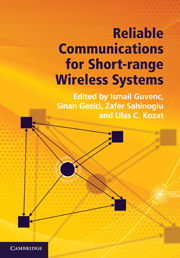Book contents
- Frontmatter
- Contents
- List of contributors
- 1 Short-range wireless communications and reliability
- Part I High-rate systems
- Part II Low-rate systems
- Part II Selected topics for improved reliability
- 11 Cooperative communications for reliability
- 12 Reliability through relay selection in cooperative networks
- 13 Fundamental performance limits in wideband relay architectures
- 14 Reliable MAC layer and packet scheduling
- Index
14 - Reliable MAC layer and packet scheduling
from Part II - Selected topics for improved reliability
Published online by Cambridge University Press: 01 June 2011
- Frontmatter
- Contents
- List of contributors
- 1 Short-range wireless communications and reliability
- Part I High-rate systems
- Part II Low-rate systems
- Part II Selected topics for improved reliability
- 11 Cooperative communications for reliability
- 12 Reliability through relay selection in cooperative networks
- 13 Fundamental performance limits in wideband relay architectures
- 14 Reliable MAC layer and packet scheduling
- Index
Summary
Medium access control (MAC) is of paramount importance in wireless systems: it orchestrates how the spectrum is shared across users and flows directly impacting the system throughput, reliability, quality of service (QoS), and fairness. Numerous works in the literature have challenged the classical layered view of protocol stacks in order to improve the poor utilization of the scarce spectrum resources [1]. Both in the context of random access and contention-free access, substantial gains have been demonstrated by making the MAC layer more aware of channel conditions and applications. Another classical view that has been challenged over the years is the tendency to emulate a point-to-point link view over inherently point-to-multipoint wireless medium. In the classical approach, packets received by unintended users are simply discarded. Originally, in the multihop routing domain, and more recently in the single-hop case, the notion of unintended user has become stale, especially in the contexts of cooperative communication, network coding, and opportunistic routing [2–5, 22].
In this chapter we focus primarily on a specific network scenario, where there is only one wireless transmitter serving many receivers. We assume a contention-free MAC: a centralized scheduler dynamically allocates channels (e.g., spreading codes and frequency subbands) to multiple users over time.
- Type
- Chapter
- Information
- Reliable Communications for Short-Range Wireless Systems , pp. 386 - 406Publisher: Cambridge University PressPrint publication year: 2011

